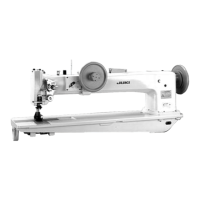i
i
For the sewing machine, automatic machine and ancillary devices (hereinafter collectively referred to as
"machine"), it is inevitable to conduct sewing work near moving parts of the machine. This means that there
is always a possibility of unintentionally coming in contact with the moving parts. Operators who actually
operate the machine and maintenance personnel who are involved in maintenance and repair of the machine
are strongly recommended to carefully read to fully understand the following
SAFETY PRECAUTIONS
before using/maintaining the machine. The content of the
SAFETY PRECAUTIONS
includes items which
DUHQRWFRQWDLQHGLQWKHVSHFL¿FDWLRQVRI\RXUSURGXFW
7KHULVNLQGLFDWLRQVDUHFODVVL¿HGLQWRWKHIROORZLQJWKUHHGLIIHUHQWFDWHJRULHVWRKHOSXQGHUVWDQGWKHPHDQLQJ
of the labels. Be sure to fully understand the following description and strictly observe the instructions.
Warning label
❶
❷
❸
❶
7KHUHLVWKHSRVVLELOLW\WKDWVOLJKWWRVHULRXVLQMXU\RUGHDWKPD\EHFDXVHG
7KHUHLVWKHSRVVLELOLW\WKDWLQMXU\PD\EHFDXVHGE\WRXFKLQJPRYLQJSDUW
❷
7RSHUIRUPVHZLQJZRUNZLWKVDIHW\JXDUG
7RSHUIRUPVHZLQJZRUNZLWKVDIHW\FRYHU
7RSHUIRUPVHZLQJZRUNZLWKVDIHW\SURWHFWLRQGHYLFH
❸
%HVXUHWRWXUQWKHSRZHU2))EHIRUHFDUU\LQJRXWPDFKLQHKHDGWKUHDGLQJ
QHHGOHFKDQJLQJEREELQFKDQJLQJRURLOLQJDQGFOHDQLQJ
❸
❷
❶
(OHFWULFDOVKRFN
GDQJHUODEHO
DANGER :
7KLVLQGLFDWLRQLVJLYHQZKHUHWKHUHLVDQLPPHGLDWHGDQJHURIGHDWKRUVHURXVLQMXU\LIWKHSHUVRQLQFKDUJHRUDQ\WKLUG
SDUW\PLVKDQGOHVWKHPDFKLQHRUGRHVQRWDYRLGWKHGDQJHURXVVLWXDWLRQZKHQRSHUDWLQJRUPDLQWDLQLQJWKHPDFKLQH
WARNING :
7KLVLQGLFDWLRQLVJLYHQZKHUHWKHUHLVDSRWHQWLDOLW\IRUGHDWKRUVHULRXVLQMXU\LIWKHSHUVRQLQFKDUJHRUDQ\WKLUG
SDUW\PLVKDQGOHVWKHPDFKLQHRUGRHVQRWDYRLGWKHGDQJHURXVVLWXDWLRQZKHQRSHUDWLQJRUPDLQWDLQLQJWKHPDFKLQH
CAUTION :
7KLVLQGLFDWLRQLVJLYHQZKHUHWKHUHLVDGDQJHURIPHGLXPWRPLQRULQMXU\LIWKHSHUVRQLQFKDUJHRUDQ\WKLUGSDU
W\PLVKDQGOHVWKHPDFKLQHRUGRHVQRWDYRLGWKHGDQJHURXVVLWXDWLRQZKHQRSHUDWLQJRUPDLQWDLQLQJWKHPDFKLQH
,WHPVUHTXLULQJVSHFLDODWWHQWLRQ
3LFWRULDOZDUQLQJLQGLFDWLRQ
7KHUHLVDULVNRILQMXU\LIFRQWDFW
LQJDPRYLQJVHFWLRQ
3LFWRULDOZDUQLQJ
LQGLFDWLRQ
%HDZDUHWKDWKROGLQJWKHVHZLQJ
PDFKLQHGXULQJRSHUDWLRQFDQ
KXUW\RXUKDQGV
7KHUHLVDULVNRIHOHFWULFDOVKRFNLI
FRQWDFWLQJDKLJKYROWDJHVHFWLRQ
7KHUHLVDULVNRIHQWDQJOHPHQWLQ
WKHEHOWUHVXOWLQJLQLQMXU\
7KHUHLVDULVNRIDEXUQLIFRQWDFW
LQJDKLJKWHPSHUDWXUHVHFWLRQ
7KHUHLVDULVNRILQMXU\LI\RX
WRXFKWKHEXWWRQFDUULHU
%HDZDUHWKDWH\HGH¿FLHQF\FDQ
EHFDXVHGE\ORRNLQJGLUHFWO\DWWKH
ODVHUEHDP
,QGLFDWLRQODEHO
7KHFRUUHFWGLUHFWLRQLVLQGLFDWHG
7KHUHLVDULVNRIFRQWDFWEHWZHHQ
\RXUKHDGDQGWKHVHZLQJPD
FKLQH
&RQQHFWLRQRIDHDUWKFDEOHLV
LQGLFDWHG
TO ENSURE SAFE USE OF YOUR SEWING MACHINE
,([SODQDWLRQRIULVNOHYHOV
(II)
([SODQDWLRQRISLFWRULDOZDUQLQJLQGLFDWLRQVDQGZDUQLQJODEHOV
– 15 –
Problems Causes Corrective measures
⑤
Height of needle bar is not matched.
⑥
When skip-stitches occur at step-sewing
part.
⑦
When the blade point of the sewing hook
is crushed.
⑧
When the needle is defective.
○ When the needle bar is at lowest point make
the distance between the bottom of needle
clamp and upper surface of throat plate to 21.
2 mm (53/64").
○ Increase the alternate lifting amount of the
presser foot.
○ Remove the sewing hook and repair with a fi ne
mesh oil whetstone or exchange the hook with
a new sewing hook.
○ Exchange with a new needle.
3. Stitching fl aw.
①
The bobbin thread is not passing the
center of the thread tension spring of
bobbin case holder.
②
The outer rim of the bobbin is not smooth.
③
When the thickness of the needle is not
matched with the using thread.
④
When the supply of oil to the sewing hook
is not adequate.
⑤
Bobbin thread tension is too weak.
○ Make the bobbin thread to pass the center of
the tension spring.
○ Exchange the bobbin or polish the outer rim of
the bobbin with a fi ne mesh paper fi le. (sand
paper).
○ Exchange with an appropriate thick needle.
○ Refer to the chapter on
"3. LUBRICATION"
.
○ Refer to the chapter on
"8. THREAD
TENSION"
.
a. In case of stitching
fl aw due to change
of sewing speed.
①
Pressure of take-up spring is too weak.
②
Timing of bobbin case opening lever is
not matched.
③
Finish of thread paths of all parts are bad.
④
Sewing hook is defective.
○ Make the strength of take-up spring stronger.
(Refer to the chapter on
"8. THREAD
TENSION"
○ Refer to the chapter on
"13. ADJUSTING THE
BOBBIN CASE OPENING LEVER"
.
○ Polish with a fi ne mesh paper fi le (sand paper)
or by buffi ng.
○ Exchange the sewing hook with a new hook.
4. On feed pitch error
a. In case feed pitch
is too big.
①
Pressing pressure of presser foot is too
weak.
○ Tighten the pressure regulating themb screw.
b. In case feed pitch
is too small.
①
Feed dog is too low.
②
Tension of needle thread and bobbin
thread is too strong.
○ Refer to the chapter on
"17. ADJUSTING THE
HEIGHT OF THE FEED DOG"
.
○ Refer to the chapter on
"8. THREAD
TENSION"
.
5. Isolated idling loops
are produced
①
Tension of the needle threa is too weak.
②
Timing of the bobbin case opening lever
is not matched.
(Pulling of the bobbin case opening lever
is insuffi cient)
○ Strengthen the tension of the needle thread.
○ Refer to the chapter on
"11. ADJUSTING THE
WALKING FOOT AND PRESSER FOOT"
.
6. Even with the safety
device in action, good
stitching condition can
not be attained.
①
When the safety device has not returned
to the correct position.
②
Due to the strong impact, sometimes the
timing belt slides by one pitch.
○ Bring the safety device to the correct position.
○ Refer to the chapter on the timing of the main
shaft and the hook shaft.

